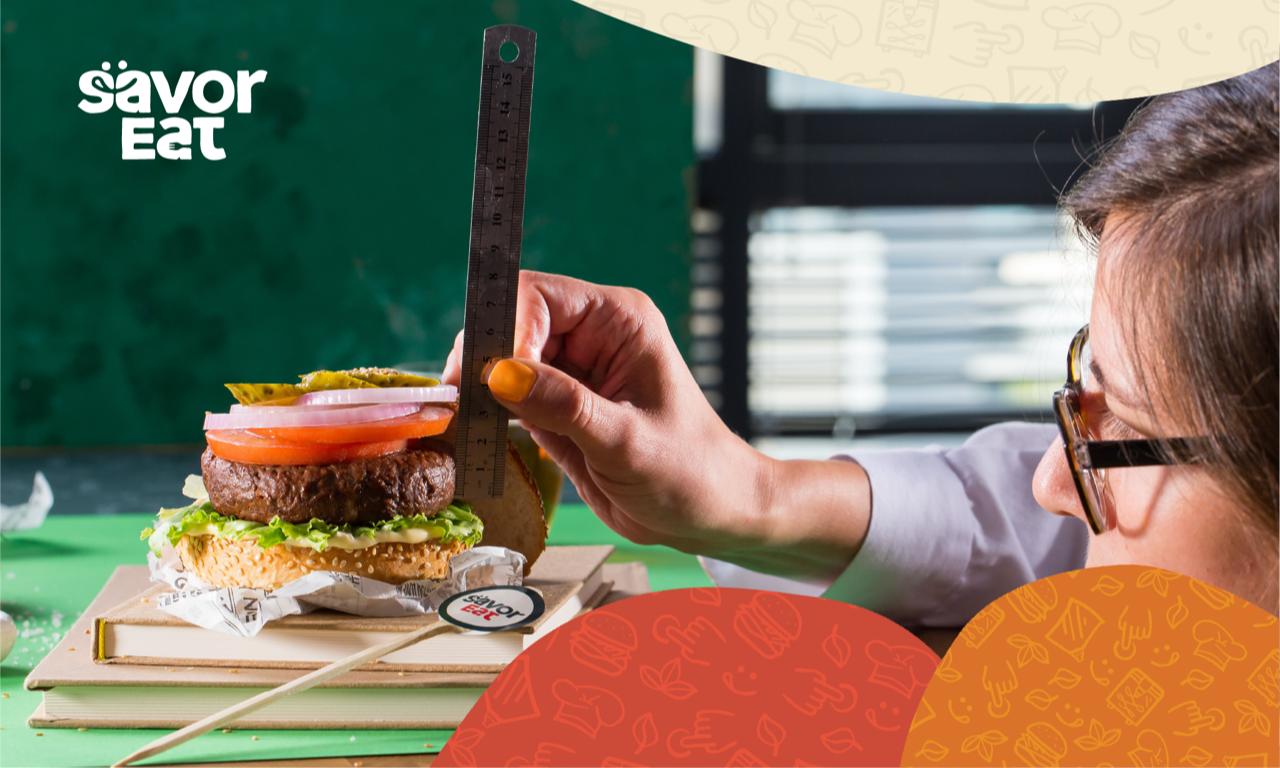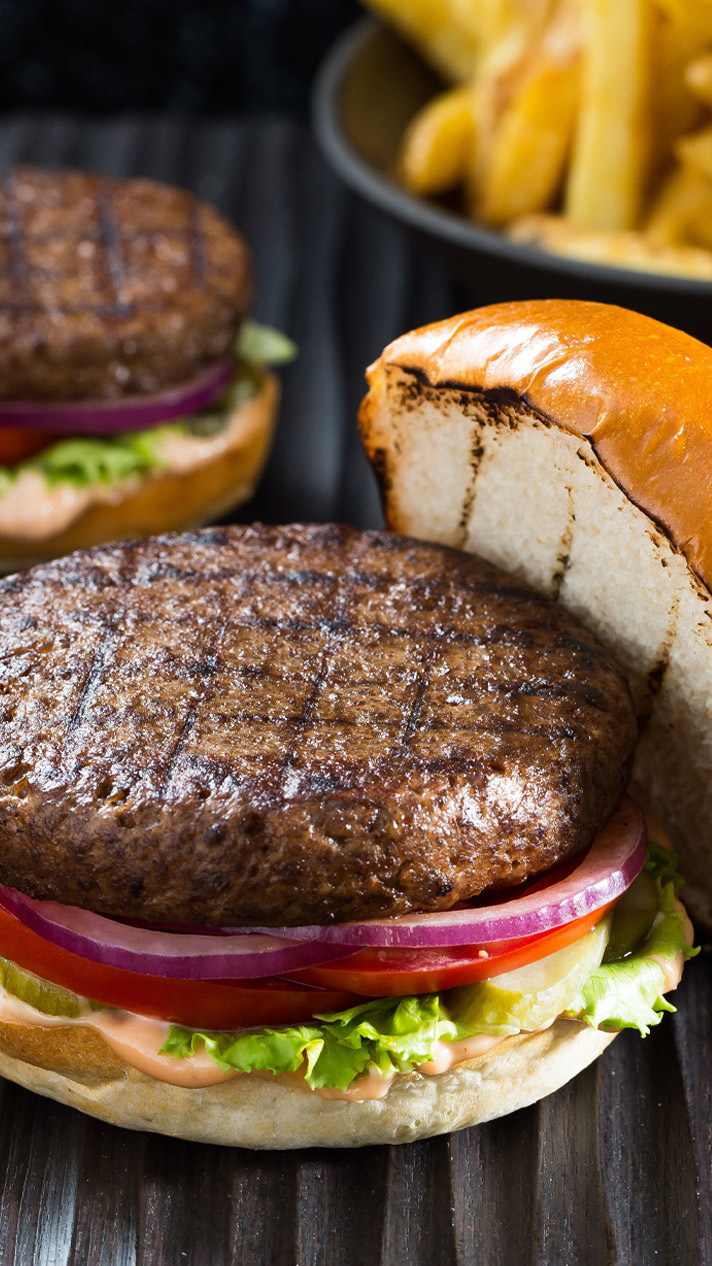Until recently, if you went into a restaurant looking for plant-based burgers, you’d get a black-bean burger. Sure, said burger came with a lot of protein, but it lacked the trickle-down-the-chin juicy deliciousness that you usually associate with a great roadside diner hamburger.
Fortunately, things have changed in the vegetarian burger world. Nowadays, the best plant-based burgers replicate the diner burger experience, down to the juices and flame-broiled taste.
And they keep evolving. In the 21st century, the most revolutionary veggie burgers are personalized right down to the poundage and made to order with precision by robot chefs and 3D printing technology.
Sounds impossible, right? It’s not.

What Are Plant-Based Burgers?
Plant-based burgers get their ingredients from plant sources, like peas, soybeans, black beans, and more. Unlike the burgers you probably grew up eating, these burgers don’t have meat in them or animal-derived products, like dairy or eggs.
What the Best Plant-Based Burgers Are Made Of
The most common ingredients for veggie burgers, according to Spooniversityare:
-
Beans and lentils
-
Grains
-
Tofu or soybeans
-
Vegetables
-
Nuts and seeds
-
Spices
Each meatless burger manufacturer uses a different combination of ingredients to create their burgers. Not all meatless burger recipes include every ingredient on the list above.
Rather, each recipe calls for its own ingredients in a specific amount, leaving out some ingredients and doubling up — so to speak — on others to allow each manufacturer to create its own version of the meatless burger.
How Do Veggie-Based Burgers Taste?
It should be noted that many people who aren’t used to eating meatless burgers sometimes don’t care for the texture. Some faux meats, in general, can have a dry texture, due to the ingredients used to make them.
Because they’re called burgers, the uninitiated expect them to taste like a juicy roadside diner hamburger. Until recently, many meatless burgers didn’t taste like the real deal.
Replicating the taste and the texture of “real” burgers has been among the biggest goals of many vegetarian burger manufacturers in recent years.
More on this in a bit…
A Look at How Standard Meatless Burgers Are Made
As far as food history goes, plant-based burgers, or veggie burgers, as they are also known, are a relatively recent phenomenon, according to Smithsonian Magazine.
Although some form of veggie burger has existed since the late 1960s, the concept didn’t gain traction until the early 1980s, when Gregory Sams put out his VegeBurger.
In terms of the production process, those burgers were a bit like falafel in that they were made from a dry mix of ingredients, then reconstituted with water and formed into burger patties. They were then frozen and shipped to wherever they were going.
Nowadays, commercial plant-based meat production begins with the individual ingredients that each manufacturer uses in its meatless burger recipe. The best plant-based burgers today add some specific ingredients that give them a meaty flavor and texture, something that was lacking in the earliest incarnations of veggie-based burgers.
Companies, like Impossible and Beyond, add specific ingredients, like coconut oil and plant heme, to create the meaty texture, juiciness, and flavor now found in many veggie burgers.
On the Assembly Line in a Meatless Meat Factory
Once the plant-based meat ingredients are mixed together, they’re then processed in the same way that animal meat is processed, according to Eater. That is to say, they go through a mixing/grinding process.
The resulting “meat” looks like ground beef (if it’s a plant-based hamburger they’re making). Once the ground beef consistency is created, the mix hits the conveyor belt, where it’s pressed into patties and frozen for transport.
In this respect, most of these faux meat manufacturers follow the traditional assembly line method of processing. Each faux burger looks pretty much like the other burgers in the package. It tastes like every other faux burger. It’s the same size and has the same micro- and macronutrients. The weight is the same, too, within a micro-percentage point in either direction. It’s an assembly line through and through.
These burgers also go through the same packaging process that most manufactured food goes through. That is to say that each individual burger is backed by some sort of wax paper and put into bags or boxes after the burger is frozen.
If you buy them in the store, you’ll likely see the faux burgers packaged in a box or a plastic bag. Usually, four to six burger patties come in the package.
Where Plant-Based Meats Are Sold
Consumers can buy vegetarian meats just about anywhere. If you’re in the grocery store, you’ll usually find these meat substitutes either in the vegan deli section of the refrigerator or in the vegan/vegetarian section of the frozen food aisle.
And remember the black bean burger in the restaurant we mentioned at the outset of this article? You can still find those in restaurants and stores, but you’ll also find other types of veggie meat now, too, including some of the newer brands, like MorningStar Farms and Impossible.
Beyond that, you’re likely to come across them in business settings, too, particularly if your place of employment has a cafeteria. Essentially, because faux meats are packaged and frozen just like regular meat is, it’s possible for food vendors to get it wherever their business is located.
That’s why you’ll likely see meatless burgers in food trucks and military kitchens, in meal kits, and on the item list for meal delivery services. (For example, you can find faux meat for sale on the Misfits Market website, and customers can order it as part of their food box for the week.)
Current Veggie Meat Trends
An article on the Guardian website points out that most food trends begin in restaurants and eventually move to the consumer level.
It’s important to mention this because, according to the article, only 20% of the food ordered in restaurant chains in the summer of 2022 contained meat (the animal kind). Additionally, only about a third of the entrees in the 150 restaurants that were surveyed for the article included meat. Only about 12% of appetizers had meat in them.
Restaurants started to cut back on meat products on their menus in part to save money and in part due to demand for vegetarian options. Nowadays, many consumers are eating healthier. As a result, their new vegan and vegetarian diets call for more plant foods.
While there is some concern about what inflation in general will do to the price of all food, there is still a trend toward meatless meals. In a December 2022 article, The Food Institute reported that nearly half of all food shoppers — roughly 40% — have said that they plan to buy more meatless foods and meals in 2023. It appears, despite inflation, consumers still plan on buying plant-based meats and other vegetarian and vegan foods.
The Evolving Plant-Based Burger: SavorEat Changes the Model
Restaurant chefs will play a role in determining how many people are willing to try plant meats in the near future. They’ll be the ones creating the bespoke vegetarian and vegan meals that win over non-vegetarians to a more plant-based way of eating.
This made-to-order model is the model that SavorEat’s robot chefs follow. These robot chefs take the assembly line aspect out of plant-based meat production, allowing each consumer to create plant-based meats that align with the demands of their diet.
Using this 3D printing technology, consumers can input their preferences, adjusting the ingredients in their meatless burger, whether they want less fat, more protein, or something else. The likelihood of someone liking the resulting burger goes up because the burger is made to order, just like it is in the restaurant, only with a 21st-century twist.
That is, where most restaurants now serve the packaged meatless burgers that they buy from the wholesaler, in the future, they’ll be able to serve a made-to-order meatless burger, using ingredients they keep on hand.
Final Thoughts on the Best Plant-Based Burgers Today
Right now, the tide is changing in the food industry, due to the convergence of a number of factors, including the trend toward vegetarianism and veganism in general, the cost of inflation, new technologies, and consumers’ preferences for personalized experiences.
These trends are bound to shape the way people eat plant meats in the future. Rather than relying on veggie meats that are factory processed just like their animal counterparts, we predict that a new trend will arise.
Consumer taste and tightening financial challenges will encourage hospitality managers and consumers alike to look for new alternatives in the plant-based meat world. The day of the robot chef that creates a made-to-order plant-based burger just for you is just around the corner.
If you’d like to learn more about our innovative technology, check out our technology or request a demo.




